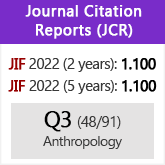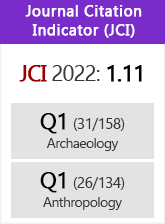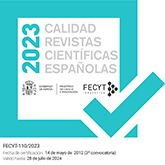Variscite and amber in the Galician Neolithic. Archaeometric analysis of the necklace from Barrow 1 at Chousa Nova, Silleda (Pontevedra, Spain)
DOI:
https://doi.org/10.3989/tp.2011.11075Keywords:
Archaeometry, Variscite, Amber, Polished industry, Neolithic, Megalithism, Galicia, XRD, WDXRF, ESEM, EDS, FTIRAbstract
The excavation of barrow 1 of Chousa Nova, Silleda, Pontevedra (NW Spain) offered surprising results. This mound, in spite of experiencing a large number and types of anthropic damage, still preserved a great constructive complexity. Within its megalithic chamber, formed by 5 granite orthostats and a large roofing slab of, also in granite, a set of archaeological materials appeared. These were an axe, a chisel and a polishing stone, with a set of 35 beads, most of them of a green stone and the rest of an organic material, with an extremely high degree of alteration, inserted between them. The analytical techniques have been in all cases not-destructives (X-ray diffraction and fluorescence spectroscopy, infrared spectroscopy, optical microscopy and environmental electronic microscopy, with microanalysis). The archaeometric analysis results show a mineralogical nature of these materials, based in variscite and amber. The textural and compositional features are very homogeneous between each assemblage of beads. The importance of the alteration phenomena and dissolution of the archaeological objects are determined and quantified. This alteration is due to an intense chemical attack during the burial periods. The possible source areas of provenance for these materials are also discussed on the basis of geochemical data obtained in the analysis.
Downloads
References
Alonso Matthías, F. y Bello Diéguez, J. M. 1995: “Aportaciones del dolmen de Dombate al megalitismo noroccidental: dataciones de carbono 14 y su contexto arqueológico”. 1.º Congresso de Arqueologia Peninsular (Porto 1993) VII. Trabalhos de Antropologia e Etnologia 35 (3): 153-181.
Álvarez Fernández, E.; Peñalver, E. y Delclós, X. 2005: “La presencia de ámbar en los yacimientos prehistóricos (del Paleolítico Superior a la Edad del Bronce) de la Cornisa Cantábrica y sus fuentes de aprovisionamiento”. Zephyrus 58: 159-182.
Anderson, K. B.; Winans, R. E. y Botto, R. E. 1992: “The nature and fate of natural resins in the geosphere -II Identification, classification and nomenclature of resinites”. Organic Geochemistry 18: 829-841. http://dx.doi.org/10.1016/0146-6380(92)90051-X
Arribas, A.; Galán, E.; Martín, J. M.; Nicolau, J. y Salvador, P. 1971: “Estudio mineralógico de la variscita de Palazuelo de las Cuevas”. Stvdia Geológica Salmanticensia 2: 115-132.
Beck, C. W.; Wilbur, E.; Meret, S.; Kossove, D. y Kermani, 1965: “The infra-red spectra of amber and the identification of Baltic amber”. Archaeometry 8: 96-109. http://dx.doi.org/10.1111/j.1475-4754.1965.tb00896.x
Domínguez-Bella, S. 2004: “Variscite, a prestige mineral in the Neolithic-Aeneolithic Europe. Raw material sources and possible distribution routes”. Slovak Geological Magazine 1-2: 151-158.
Domínguez-Bella, S.; Álvarez Rodríguez, M.ª A. y Ramos Muñoz, J. 2001: “Estudio analítico de las cuentas de collar de ámbar del dolmen de Alberite (Villamartín, Cádiz). Naturaleza química y mineralógica e implicaciones sobre su origen”. En B. Gómez Tubío, M. A. Respaldiza y M. L. Pardo (eds.): III Congreso Nacional de Arqueometría (Sevilla 1999): 621-630. Sevilla.
Domínguez-Bella, S. y Morata Céspedes, D. 1995: “Aplicación de las técnicas mineralógicas y petrológicas a la arqueometría. Estudio de materiales del dolmen de Alberite (Villamartín, Cádiz)”. Zephyrus XLVIII: 129-142.
Domínguez Bella, S.; Nieto, J. M.; Nocete, F.; Calvo Ramos Muñoz, J. y Sáez R. 2003: “ICP-MS en Arqueometria. Variscitas arqueológicas en el oeste peninsular, Origen de las materias primas geológicas”. Boletín de la Sociedad Española de Mineralogía 26-A: 113-114.
Domínguez-Bella, S.; Ramos Muñoz, J.; Álvarez, M. A. y Forteza, M. 1998: “Neolithic amber. Mineralogical and chemical characterization of amber necklace beads from Alberite Dolmen. Villamartín, Cádiz, Spain”. Libro de Abstracts del World Congress on Amber Inclusions: 155. Vitoria.
Fábregas Valcarce, R. 1992: Megalitismo del Noroeste de la Península Ibérica. Tipología y secuencia de los materiales líticos. Universidad Nacional de Educación a Distancia. Madrid.
Fábregas Valcarce, R.; Bonilla Rodríguez, A. y César Vila, M. 2007: Monte dos Remedios (Moaña, Pontevedra). Un asentamiento de la prehistoria reciente. Tórculo. Santiago de Compostela.
Fábregas Valcarce, R. y Vilaseco Vázquez, X. I. 2006: “En torno al megalitismo gallego”. En R. Fábregas Valcarce y F. Carrera Ramírez (eds.): Arte Parietal Megalítico en el Noroeste Peninsular. Conocimiento y conservación. Tórculo. Santiago de Compostela: 11-36.
Lima Oliveira, E. 2000: La Arqueología en la Gasificación de Galicia 12: intervenciones en yacimientos prehistóricos. Laboratorio de Arqueoloxía e Formas Culturais, Universidade de Santiago de Compostela. Santiago de Compostela.
Mañana Borrazás, P. 2005: “Túmulo 5 de Forno dos Mouros (Ortigueira, A Coruña). Primeiros resultados”. Cuadernos de Estudios Gallegos LII: 39-79.
Ramos, J. y Giles, F. (eds.) 1996: El dolmen de Alberite (Villamartín). Aportaciones a las formas económicas y sociales de las comunidades neolíticas en el Noroeste de Cádiz. Universidad de Cádiz y Ayuntamiento de Villamartín. Cádiz.
Reimer, P. J.; Baillie, M. G. L.; Bard, E.; Bayliss, A.; Beck, J. W.; Blackwell, P. G.; Buck, C. E.; Burr, G. S.; Cutler, K. B.; Damon, P. E.; Edwards, R. L.; Fairbanks, R. G.; Friedrich, M.; Guilderson, T. P.; Herring, C.; Hughen, K. A.; Kromer, B.; McCormac, F. G.; Manning, S. W.; Ramsey, C. B.; Reimer, P. J.; Reimer, R. W.; Remmele, S.; Southon, J. R.; Stuiver, M.; Talamo, S.; Taylor, F. W.; Van der Plicht, J. y Weyhenmeyer, C. E. 2004: “INTCAL04 terrestrial radiocarbon age calibration, 0-26 cal kyr BP”. Radiocarbon 46-3: 1029-1058.
Savkevich, S. y Shaks, I. 1964: “Infrared absorption spectra of Baltic amber (Succinite)”. Zhurnal Prikladnoi Chimii 37: 1120-1122.
Vaquero Lastres, J. 1999: Les extrêmes distincts. La configuration de l’espace dans les sociétés ayant batî des tertres funéraires dans le Nord-Ouest Iberíque. British Archaeological Reports International Series 821. Tempus Reparatum. Oxford.
Vijande, E. 2009: “El poblado de Campo de Hockey (San Fernando, Cádiz): resultados preliminares y líneas de investigación futuras para el conocimiento de las formaciones sociales tribales en la Bahía de Cádiz (tránsito V.º-IV.º milenios a.n.e.)”. RevistaAtlántica-Mediterránea de Prehistoria y Arqueología Social XI: 265-284.
Vilaça, R.; Beck, C. W. y Shout, E. C. 2002: “Provenience analysis of prehistoric amber artifacts in Portugal”. Madrider Mitteilungen 43: 61-74.
Vilaseco Vázquez, X. I. 1997/98: “Datos sobre a presenza de estruturas de acceso en túmulos megalíticos da provincia de Lugo”. Boletín do MuseoProvincial de Lugo VIII (1): 125-156.
Vilaseco Vázquez, X. I. 2006: “Á beira da morte. Algúns exemplos europeos sobre a utilización do contorno inmediato aos monumentos megalíticos funerarios como posíbeis modelos para Galicia”. Gallaecia 25: 7-44
Downloads
Published
How to Cite
Issue
Section
License
Copyright (c) 2011 Consejo Superior de Investigaciones Científicas (CSIC)

This work is licensed under a Creative Commons Attribution 4.0 International License.
© CSIC. Manuscripts published in both the printed and online versions of this Journal are the property of Consejo Superior de Investigaciones Científicas, and quoting this source is a requirement for any partial or full reproduction.All contents of this electronic edition, except where otherwise noted, are distributed under a “Creative Commons Attribution 4.0 International” (CC BY 4.0) License. You may read here the basic information and the legal text of the license. The indication of the CC BY 4.0 License must be expressly stated in this way when necessary.
Self-archiving in repositories, personal webpages or similar, of any version other than the published by the Editor, is not allowed.

















